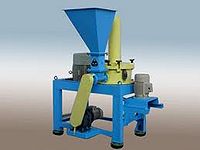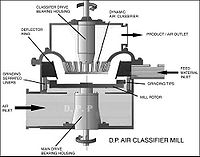Air Classifier Mills
Air Classifier Mills are designed for producing micro-fine particle size. High air, unique multi teeth rotor and serrated liners fitted in the air classifier mills create numerous air whirls, turbulence and progressive grinding. The air classifier mills are designed to control the top cut size, great turbulence, and high air whirls to ensure minimum temperature increase to handle heat sensitive materials. The classifier retains coarser particles while suction fan discharges fine powder through cyclone separators and dust is collected in filter bag units. All air classifier mills are supplied with pneumatic conveying system.
Operating Principle
Referring to the schematics given, most of the processing air or gas enters through the bottom section of the mill. Up to 30% of the total airflow can be introduced with the feed material. Concurrent with this constant mass flow of gas, feed material is introduced to the mill ideally in a constant mass flow manner.
For most applications, material is introduced to the tip of the rotating hammers through a port opening at the side of the mill. Feed material can be either pneumatically conveyed or screw fed. The rotating hammers attached to the impact rotor disc serve to fracture the process material.
A serrated liner mounted on the periphery of the grinding chamber in the hammer path serves to improve grinding efficiency by preventing particles from accelerating to the speed of the hammers thereby increasing the relative speed difference.
The primary airflow passing through the narrow annular gap formed in between the liner and impact rotor disc in conjunction with the fanning action of the hammers transports the material to the top of the mill. A dispersion ring then directs the material downward toward the classifier. Baffles welded to a shroud ring straighten the flow of material and air so that particle vortexing at the dispersion ring area is avoided.
The shroud assembly effectively separates the grinding zone from the classification zone as well as providing a defined path for the material and air to flow through.
Common Features
- Resistance to wear and tear
- Sturdy build
- Easy installation
- Compactness
- Simple design
- Low maintenance
- Cost-efficiency
- Superior quality
Applications
- Aluminium Oxide
- Graphite
- Calcined Magnetite
- P.V.C. Resin
- Cement
- Limestone
- Talc
- Clays
- Metallurgical Powders
- Pigments
- Fly Ash
- Silica
- Soya flour
- Hydrated lime
- Food Products
- Chemicals
Video


